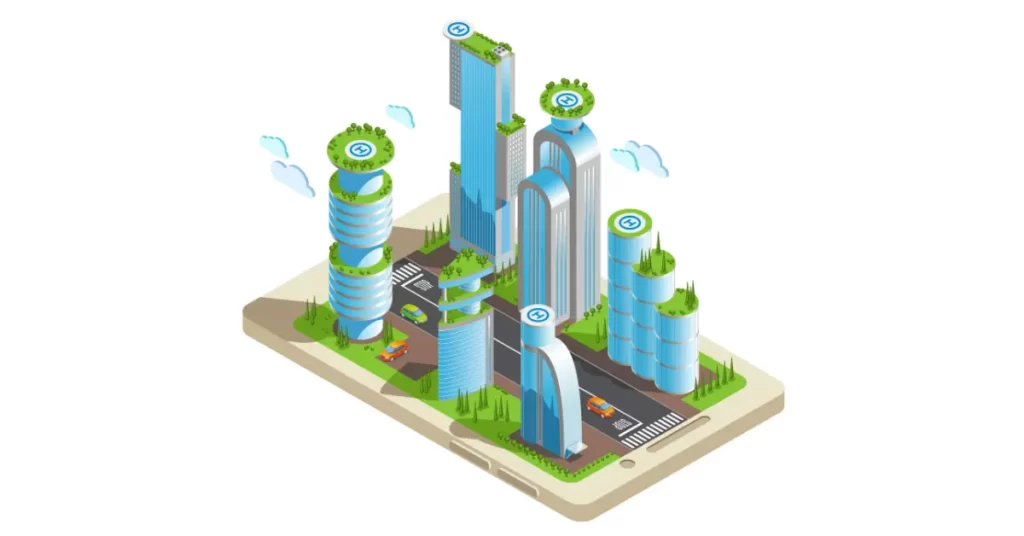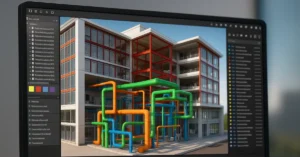In recent years, the Role of BIM in Sustainable Building Design has become increasingly important as we face the challenges of climate change and dwindling natural resources. Architects and engineers are looking for ways to optimize sustainability while also reducing costs. One tool that has emerged as a game-changer in the construction industry is Building Information Modelling (BIM).
BIM is a digital representation of a building’s physical and functional characteristics. It is a powerful tool that enables architects, engineers, and construction professionals to design, simulate, and analyze a building’s performance before construction begins. By using BIM, designers can optimize energy efficiency, reduce waste, and lower costs. Here are some of the ways that BIM can benefit sustainable building design.

The Role of BIM in Sustainable Building Design: An Essential Guide
- Optimizing Energy Efficiency
One of the primary benefits of BIM is its ability to optimize energy efficiency. BIM allows architects and engineers to simulate a building’s energy performance and identify areas where energy consumption can be reduced. By analyzing a building’s energy consumption, designers can make informed decisions about which materials and technologies to use to improve the building’s energy performance.
- Reducing Waste
Another benefit of BIM is that it can help reduce waste during construction. By using BIM, designers can optimize the use of materials, reducing the amount of waste generated during construction. BIM also allows designers to simulate the construction process, identifying potential conflicts and ensuring that materials are delivered to the site in the correct sequence, reducing waste and improving efficiency.
- Lowering Costs
BIM can also help lower construction costs. By optimizing energy efficiency and reducing waste, designers can reduce the overall cost of the project. BIM can also help identify potential conflicts early in the design process, avoiding costly rework during construction. By identifying potential conflicts early, designers can ensure that construction proceeds smoothly and on schedule, reducing the cost of the project.
- Improving Collaboration
BIM is a collaborative tool that enables architects, engineers, and construction professionals to work together seamlessly. By using BIM, designers can share information in real-time, ensuring that everyone is working from the same set of data. This helps to reduce errors and misunderstandings, improving collaboration and reducing the risk of costly mistakes.
- Enhancing Safety
BIM can also enhance safety on the construction site. By simulating the construction process, designers can identify potential hazards and address them before construction begins. BIM also allows designers to create detailed construction plans, ensuring that workers have the information they need to work safely.
- Facilitating Maintenance and Operation
BIM also facilitates maintenance and operation of the building. As a digital model of the building, BIM provides a wealth of information about the building’s systems, components, and materials. This information can be used to create an effective maintenance plan that ensures the building operates at optimal levels throughout its lifecycle. BIM also allows for the tracking of building performance, which can be used to identify areas that need improvement and optimize the building’s energy efficiency.
- Supporting Green Building Certification
BIM can also support the certification process for green building standards, such as LEED and BREEAM. BIM can provide the necessary documentation and information to support certification requirements, such as energy modeling, material sourcing, and construction waste management. By using BIM to support green building certification, designers can ensure that their buildings meet the highest standards of sustainability.
- Enabling Prefabrication and Modular Construction
BIM can also enable prefabrication and modular construction. By simulating the construction process, BIM can identify opportunities for prefabrication and modularization, which can reduce waste, improve efficiency, and lower costs. BIM can also help to optimize the design of prefabricated and modular components, ensuring that they fit together seamlessly during construction.
- Improving Building Performance
Finally, BIM can help to improve the performance of the building over its lifecycle. By using BIM to track building performance, designers can identify areas where the building can be optimized for energy efficiency, comfort, and safety. BIM can also be used to predict the building’s performance under different scenarios, such as changes in occupancy or weather conditions.
Conclusion
Building Information Modelling (BIM) is an essential tool for sustainable building design. BIM can optimize energy efficiency, reduce waste, lower costs, improve collaboration, enhance safety, facilitate maintenance and operation, support green building certification, enable prefabrication and modular construction, and improve building performance. By using BIM as part of their sustainable building design process, architects, engineers, and construction professionals can create buildings that are more energy-efficient, cost-effective, and environmentally friendly.
However, it’s important to note that BIM is not a silver bullet. BIM is a tool that must be used by knowledgeable professionals who understand the principles of sustainable building design. BIM is also only as effective as the data that is inputted into it, so it’s essential that accurate and comprehensive data is used throughout the design process.
Overall, the benefits of BIM for sustainable building design are clear. By embracing BIM, designers can create buildings that are not only beautiful and functional but also sustainable and environmentally friendly. As we face the challenges of climate change and dwindling natural resources, sustainable building design has never been more important, and BIM is an essential tool for achieving it.
For more SketchUp tutorials you can check out https://www.sketchupguru.com/blog/
You can also check more tutorial videos for sketchup on our YouTube Channel,
https://www.youtube.com/c/SketchupGuru
To know about the Top Online 3D Rendering Courses for 2022 click,










